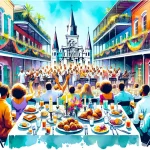The Cochon de Lait Festival in Mansura, Louisiana, celebrates culinary heritage and community spirit through the tradition of slow-roasting suckling pigs over an open fire. This annual event pays tribute to the region’s Cajun and Creole influences.
In This Article
TL;DR
- The festival originated as a local gathering for Mansura’s centennial in 1960 and has grown into a major tourist attraction showcasing Louisiana’s culinary traditions.
- Planning involves securing accommodations and preparing for warm weather with appropriate clothing and hydration.
- Highlights include savoring cochon de lait dishes, enjoying live music, participating in cultural activities, and immersing in the lively atmosphere.
Historical Background of Cochon de Lait
The term “cochon de lait” translates to “suckling pig,” referring to a young pig still nursing from its mother. This culinary tradition has rural roots in Louisiana, where families would gather to roast a whole pig over an open fire, often using hardwood logs for a distinct smoky flavor.
The festival was born out of Mansura’s centennial celebration in 1960, where residents organized a pig roast to commemorate the occasion. The event’s success led to it becoming an annual tradition, and Mansura earned the title of “Cochon de Lait Capital of the World” by an act of the Louisiana legislature.
Over the years, the festival has evolved from a local gathering into a major tourist attraction, showcasing Louisiana’s unique cultural blend of French, Spanish, African, and Native American influences, contributing to the state’s distinct cuisine.
Planning Your Visit
The Cochon de Lait Festival typically takes place in mid-May, when the weather in Louisiana is warm and inviting. Advance planning is essential.
Accommodations and Tickets
Secure accommodations early, as the festival draws large crowds. Consider hotels or vacation rentals in Mansura or nearby towns like Marksville or Bunkie for proximity to the venue. Book tickets in advance to take advantage of potential discounts or packages, as popular events can sell out quickly.
Navigating the Festival
The Cochon de Lait Center serves as the heart of the event, featuring the main stage for live music and various food vendors offering cochon de lait dishes and other local specialties.
Transportation and Parking
Surrounding areas offer unique experiences, such as the Kids’ Zone with carnival rides and games, and the Craft Fair showcasing local artisans’ handmade goods. Ample parking is available in designated lots, and shuttle services or ride-sharing options may be offered from nearby towns or cities.
Culinary Highlights
The star of the festival is the cochon de lait dish itself. Preparation begins days in advance, with the suckling pigs being seasoned and marinated in a blend of spices and herbs before being slowly roasted over an open fire until tender and crispy.
Cochon de lait is served in various forms, such as po’boy sandwiches, plates with sides like dirty rice or cornbread dressing, or even as part of a cochon de lait pizza. The flavors are rich, smoky, and subtly spiced, capturing the essence of Louisiana cuisine.
Other Local Dishes
In addition to cochon de lait, the festival offers a wide array of other local dishes, including gumbo, jambalaya, boudin (Cajun sausage), crawfish étouffée, beignets, pralines, and king cake. Budget accordingly, as festival fare can be more expensive than typical restaurant meals, but vendors often offer sample sizes or smaller portions.
Activities and Entertainment
Beyond the culinary offerings, the festival features a diverse lineup of live music performances showcasing local and regional bands in genres like Cajun, zydeco, blues, and country.
Other entertainment options include cultural demonstrations, cooking workshops, interactive exhibits, games, and competitions like hog-calling contests, boudin-eating contests, and a greasy pig chase for kids.
Tips for First-Time Visitors
Be prepared for the warm Louisiana weather and crowds by wearing comfortable walking shoes, lightweight and breathable clothing, and bringing a hat or umbrella for shade. Stay hydrated by carrying a refillable water bottle.
Bring a small backpack or cross-body bag for essentials like sunscreen, snacks, and purchases. Cash is often preferred by vendors. Be respectful of the local culture and traditions, observe posted rules, and be mindful of your surroundings, especially in crowded areas.
Prioritize safety by keeping valuables secure, being aware of your surroundings, and establishing a meeting point if attending with children.
Engaging with the Local Community
Attending the festival is an opportunity to support and engage with the local community by patronizing food vendors, craft vendors, and local businesses, many of which are small, family-owned operations.
Educational exhibits and demonstrations provide insights into Louisiana’s rich history and cultural traditions. Opportunities may be available to volunteer or participate in community-driven activities, such as assisting with setup and cleanup or participating in cultural demonstrations or workshops.
By engaging with the local community, you enhance your own experience while contributing to the preservation and promotion of the region’s unique cultural identity.






